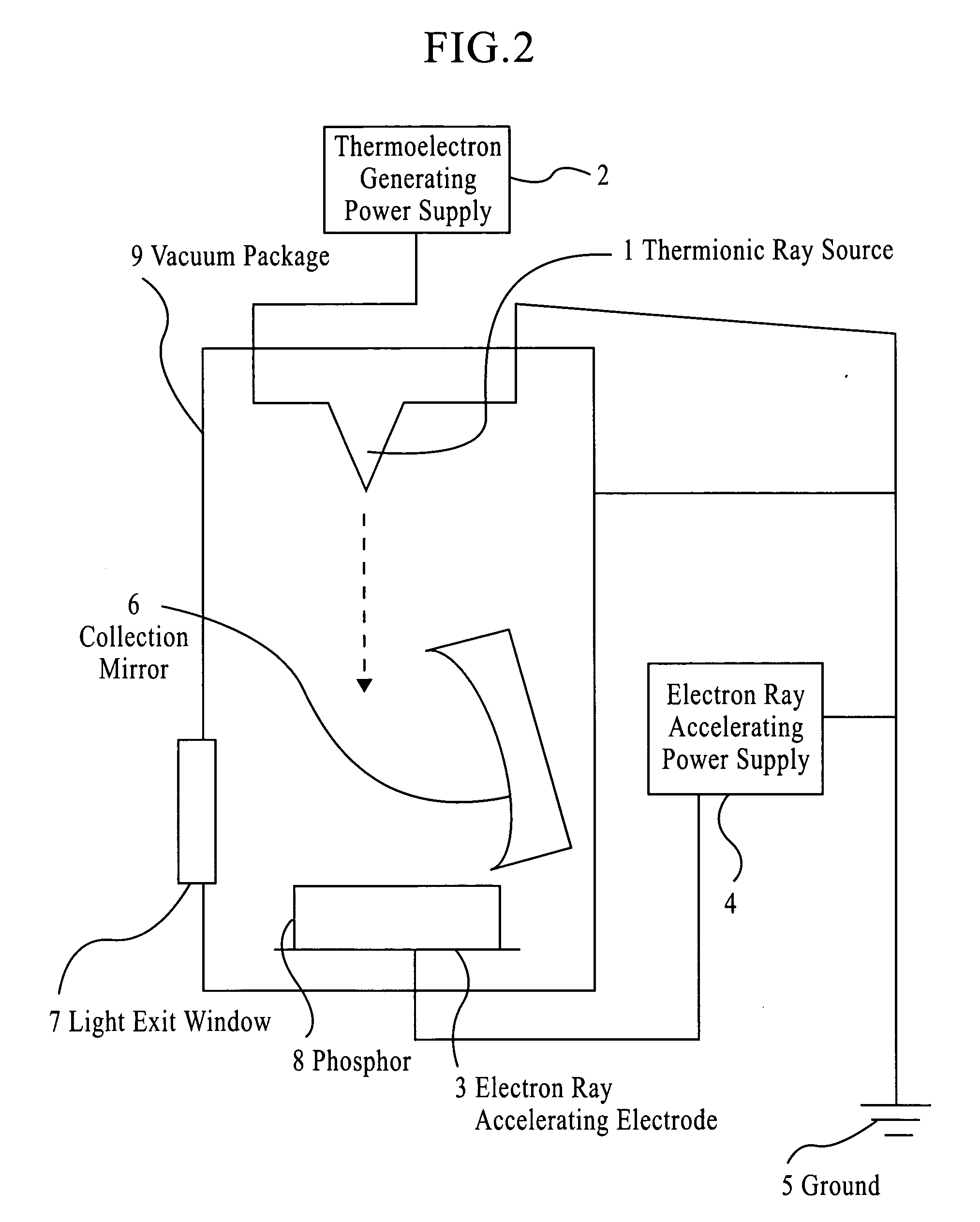Zinc oxide phosphor, process die producing the same and light emitting device
a technology of zinc oxide phosphor and process die, applied in the direction of discharge tube luminescnet screen, cellulosic plastic layered product, natural mineral layered product, etc., to achieve the effect of improving the function of phosphor
- Summary
- Abstract
- Description
- Claims
- Application Information
AI Technical Summary
Benefits of technology
Problems solved by technology
Method used
Image
Examples
example
Example 1
[0079] A gallium oxide powder and a lithium carbonate powder were mixed with a general commercial powder reagent of 99.999% purity zinc oxide so that the atomic ratios of gallium and lithium to zinc were 1 / 1000 and 1 / 10000, respectively. Then, the resulting mixed powder was placed in an alumina porcelain, set in an electric furnace which was a general heating device, and then reacted at 800° C. for 3 hours in an oxygen atmosphere supplied from a commercial oxygen gas cylinder. As a result, the lithium carbonate used as a lithium source was particularly decomposed to release carbon dioxide gas by vaporization. In this step, the amount of the lithium added was decreased so as not to increase resistance.
[0080] Then, a load of 1 ton was applied to the resulting reaction product to form a pellet having a diameter of 10 mm and a thickness of 3 mm. The pellet was again placed in an alumina porcelain, set in an electric furnace which was a general heating device, and then baked a...
example 2
[0085] The zinc oxide phosphor prepared in EXAMPLE 1 was irradiated with plasma produced by a plasma generator as described in the above-described Patent Publication No. 2920207, i.e., inductively coupled plasma produced by applying radio-waves to a mixed gas of hydrogen gas and Ar gas, to produce a zinc oxide phosphor doped with hydrogen. The zinc oxide phosphor treated in this example had a pellet form having a diameter of about 8 mm and a thickness of about 2 mm, and the plasma irradiation time was 5 minutes. The phosphor doped with hydrogen by the plasma treatment was excited with electron rays by the same method as in EXAMPLE 1, and the emission spectrum thereof was observed. The results are shown in FIG. 6. In FIG. 6, the spectrum of the phosphor before hydrogenation has a pattern shown by a bold line, and the spectrum after hydrogenation has a pattern shown by a thin line. As seen from FIG. 6, the luminous efficiency of the zinc oxide phosphor is improved by hydrogenation tre...
example 3
[0086] The zinc oxide phosphor prepared in EXAMPLE 1 was annealed at 1100° C. for 6 hours in an oxygen atmosphere. FIG. 7 shows an emission spectrum (sunlight) of the phosphor before annealing and an emission spectrum (thin line) of the annealed product under irradiation with electron rays accelerated to 5 KeV.
[0087] The two spectra were obtained using the same apparatus under the same measurement conditions, thereby permitting intercomparison therebetween. The spectrum of the phosphor annealed in oxygen gas has higher intensity. Namely, the phosphor with higher luminous efficiency is produced by annealing in oxygen. However, even when the annealed phosphor was further annealed in oxygen for 6 hours, a significant improvement in luminous efficiency was not observed. In other words, annealing has the function to recover the luminous efficiency of a phosphor in which a decrease in luminous efficiency is observed for some reason, and annealing of a phosphor initially having high lumin...
PUM
| Property | Measurement | Unit |
|---|---|---|
| Nanoscale particle size | aaaaa | aaaaa |
| Nanoscale particle size | aaaaa | aaaaa |
| Nanoscale particle size | aaaaa | aaaaa |
Abstract
Description
Claims
Application Information
 Login to View More
Login to View More - R&D
- Intellectual Property
- Life Sciences
- Materials
- Tech Scout
- Unparalleled Data Quality
- Higher Quality Content
- 60% Fewer Hallucinations
Browse by: Latest US Patents, China's latest patents, Technical Efficacy Thesaurus, Application Domain, Technology Topic, Popular Technical Reports.
© 2025 PatSnap. All rights reserved.Legal|Privacy policy|Modern Slavery Act Transparency Statement|Sitemap|About US| Contact US: help@patsnap.com



